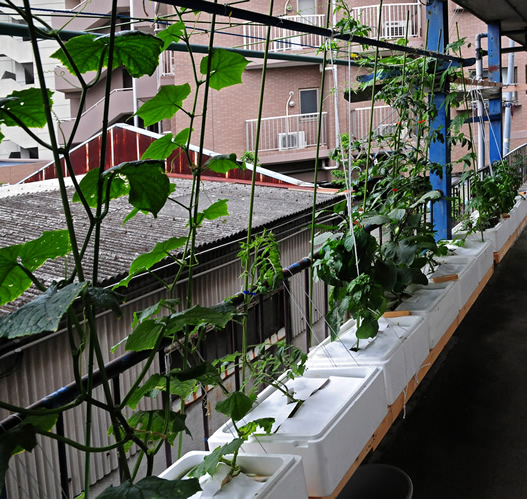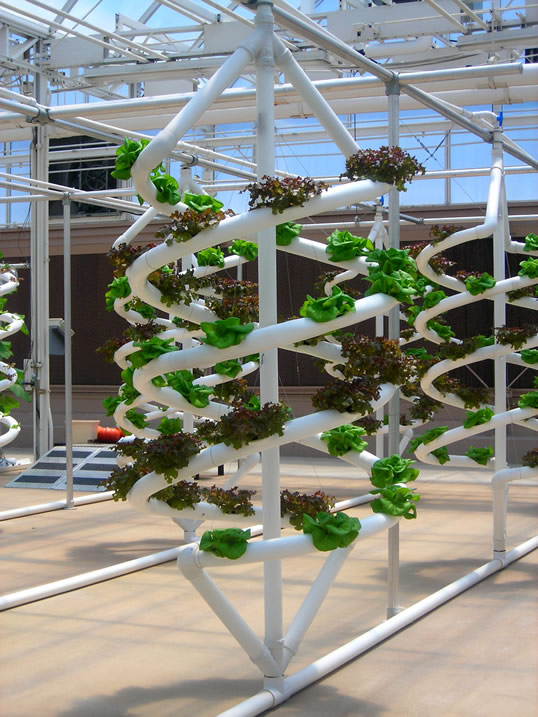 |
| Hydroponics |
Literally “water culture,” hydroponics originally referred to the growth of plants in a liquid medium. It now applies to all systems used to grow plants in nutrient solutions with or without the addition of synthetic soil for mechanical support.
Hydroponics has become an important method of crop production with the increase in the number of commercial greenhouse operations. Greenhouses are utilized in the production of a wide array of bedding plants, flowers, trees, and shrubs for commercial as well as home and garden use.
Cash receipts from greenhouse and nursery crops total more than $4 billion annually. In some arid regions, the majority of vegetable crops are produced in greenhouses.
  |
Types of Systems
The four most commonly used hydroponic systems are sand-culture systems, aggregate systems, nutrient film techniques, and floating systems. While these systems are similar in their use of nutrient solutions, they vary in both the presence and type of supporting medium and in the frequency of nutrient application.
In sand culture, coarse sand is used in containers or spread over a greenhouse floor or bed, on top of a recirculating drain system. A drip irrigation system is used to apply nutrient solution periodically, and a drainage system is used to collect the excess solution as it drains through the sand.
 |
| aggregate open system |
In an aggregate open system, plants are transplanted into plastic troughs filled with an inert supporting material, and nutrient solution is supplied via drip irrigation. The aggregate system and the sand culture are open systems because the nutrient solution is not recycled.
In the nutrient film technique, there is no supporting material. Seedlings are transplanted into troughs through which the nutrient solution is channeled, and the plants are in direct contact with the nutrient solution.
In this closed system, the nutrient solution is channeled past the plant, collected, and reused. The floating hydroponic system involves the floating of plants over a pool of nutrient solution.
   |
While the nutrient film technique and floating hydroponic systems are primarily used in research applications, the sand culture and aggregate systems are commonly used in commercial plant production. These two systems require the use of a nutrient solution and synthetic soil for mechanical support. A variety of nutrient solutions have been formulated since the first was developed in 1950.
Mechanical Support Materials
A large variety of both organic and inorganic materials have been used to formulate the synthetic soils used for mechanical support in hydroponic systems. Commonly used organic materials include sphagnum moss, peat, manure, wood, and other plant residues.
Sphagnum moss, the shredded, dehydrated remains of several species of moss in the genus Sphagnum, is harvested for the purpose of producing synthetic soil. “Peat” is a term normally used to describe partially decomposed remains of wetlands vegetation that has been preserved under water.
Peat moss is the only type of peat suitable for synthetic soil mixes. Peat moss is harvested from peat bogs, dried, compressed into bales, and sold. Animal manures are almost never used in commercial synthetic soil mixtures because they require costly handling and sterilization procedures.
Wood residues such as tree bark, wood chips, shavings, and sawdust are generally produced as by-products of the timber industry. A variety of other plant residues, including corn cobs, sugar-cane stems, straw, and peanut and rice hulls have been substituted for peat in synthetic soil mixtures where there is a supply of these materials.
Commonly used inorganic materials include vermiculite, sand, pumice, perlite, cinders, and calcined clay. Vermiculite is a very lightweight material produced by heating mica to temperatures above 1,090 degrees Celsius (nearly 2,000 degrees Fahrenheit).
Sand is a preferred material for formulating synthetic soils because it is inert and inexpensive but very heavy compared to other commonly used materials. Pumice, a natural, glass like material produced by volcanic action, provides a good inert supporting material when ground into small particles.
 |
| Hydroponics sideview |
Perlite, a porous material that will hold three to four times its weight in water, is produced by heating lava at temperatures above 760 degrees Celsius (1,400 degrees Fahrenheit). Cinders are derived from coal residues that have been thoroughly rinsed to remove harmful sulfates. Calcined clay is derived from the mineral montmorillonite baked at temperatures above 100 degrees Celsius.
